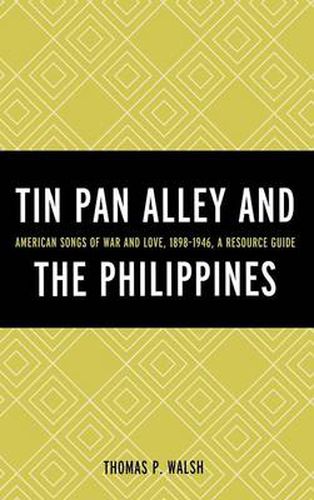Readings Newsletter
Become a Readings Member to make your shopping experience even easier.
Sign in or sign up for free!
You’re not far away from qualifying for FREE standard shipping within Australia
You’ve qualified for FREE standard shipping within Australia
The cart is loading…






This title is printed to order. This book may have been self-published. If so, we cannot guarantee the quality of the content. In the main most books will have gone through the editing process however some may not. We therefore suggest that you be aware of this before ordering this book. If in doubt check either the author or publisher’s details as we are unable to accept any returns unless they are faulty. Please contact us if you have any questions.
In this innovative resource, Thomas P. Walsh has compiled a unique collection of some 1,400 published and unpublished American musical compositions related to the Philippines during the American colonial era from 1898 to 1946. For the guide, Walsh surveyed a wide array of sources: published songs listed in WorldCat, online catalogs of sheet music collections of university libraries and major public and private research libraries, bibliographic compilations of popular music, periodical literature on music and popular culture, published collections of soldier songs, and sheet music listed for sale on commercial auction websites. The guide also identifies from song registrations in the U.S. Copyright Office’s Catalog of Copyright Entries (CCE) forty-eight years of musical compositions relating to the Philippines. By systematically going through the CCE, year by year, Walsh discovered hundreds of unpublished songs written by average Americans expressing their varied views about historical events and personal experiences in America’s faraway Southeast Asian colony.
Although most of the chronologically listed songs will be new to scholars and students, songs like Ma Little Cebu Maid,
My Own Manila Sue,
My Fillipino Belle,
Down on the Philippine Isles,
Beside the Pasig River,
My Philippino Pearl, and I Want a Filipino Man were all published and widely promoted by Tin Pan Alley, as well as performed on stage, and listened to on records and piano rolls across America. The lyrics often illustrate popular American attitudes, from shrilly patriotic numbers about the Battle of Manila Bay and the later Fall of Bataan and Corregidor to wistful, romantic, and even charming reminiscences of happy days spent in old Manila to racially charged pieces rife with deprecating stereotypes of Filipinos. The book reprints a number of hard-to-find song lyrics, making them available to readers for the first time in more than a century. It also provides copyright registration numbers and dates of registration for many published and unpublished songs. Finally, more than 700 notes on particular songs and numerous links provide direct access to bibliographic records or digital copies of sheet music in libraries and collections.
Exhaustive in scope, Tin Pan Alley and the Philippines is an invaluable resource for scholars and students of American history, Pacific studies, popular culture, and ethnomusicology.
$9.00 standard shipping within Australia
FREE standard shipping within Australia for orders over $100.00
Express & International shipping calculated at checkout
This title is printed to order. This book may have been self-published. If so, we cannot guarantee the quality of the content. In the main most books will have gone through the editing process however some may not. We therefore suggest that you be aware of this before ordering this book. If in doubt check either the author or publisher’s details as we are unable to accept any returns unless they are faulty. Please contact us if you have any questions.
In this innovative resource, Thomas P. Walsh has compiled a unique collection of some 1,400 published and unpublished American musical compositions related to the Philippines during the American colonial era from 1898 to 1946. For the guide, Walsh surveyed a wide array of sources: published songs listed in WorldCat, online catalogs of sheet music collections of university libraries and major public and private research libraries, bibliographic compilations of popular music, periodical literature on music and popular culture, published collections of soldier songs, and sheet music listed for sale on commercial auction websites. The guide also identifies from song registrations in the U.S. Copyright Office’s Catalog of Copyright Entries (CCE) forty-eight years of musical compositions relating to the Philippines. By systematically going through the CCE, year by year, Walsh discovered hundreds of unpublished songs written by average Americans expressing their varied views about historical events and personal experiences in America’s faraway Southeast Asian colony.
Although most of the chronologically listed songs will be new to scholars and students, songs like Ma Little Cebu Maid,
My Own Manila Sue,
My Fillipino Belle,
Down on the Philippine Isles,
Beside the Pasig River,
My Philippino Pearl, and I Want a Filipino Man were all published and widely promoted by Tin Pan Alley, as well as performed on stage, and listened to on records and piano rolls across America. The lyrics often illustrate popular American attitudes, from shrilly patriotic numbers about the Battle of Manila Bay and the later Fall of Bataan and Corregidor to wistful, romantic, and even charming reminiscences of happy days spent in old Manila to racially charged pieces rife with deprecating stereotypes of Filipinos. The book reprints a number of hard-to-find song lyrics, making them available to readers for the first time in more than a century. It also provides copyright registration numbers and dates of registration for many published and unpublished songs. Finally, more than 700 notes on particular songs and numerous links provide direct access to bibliographic records or digital copies of sheet music in libraries and collections.
Exhaustive in scope, Tin Pan Alley and the Philippines is an invaluable resource for scholars and students of American history, Pacific studies, popular culture, and ethnomusicology.